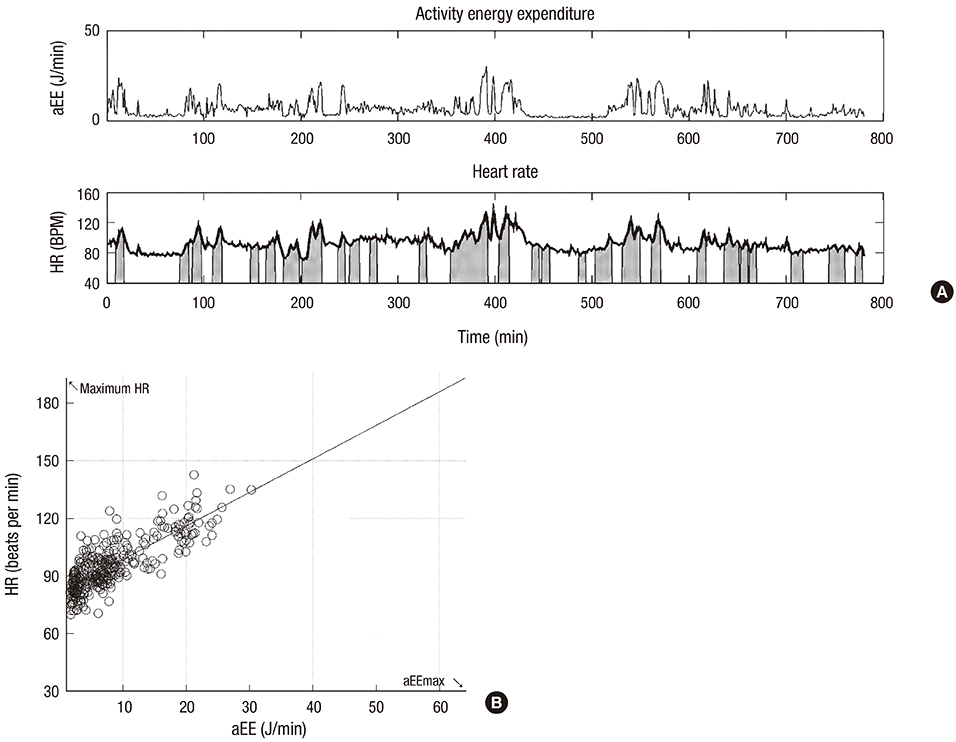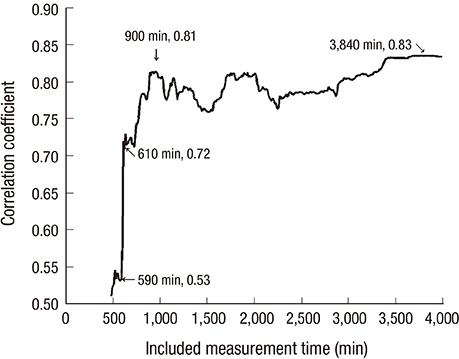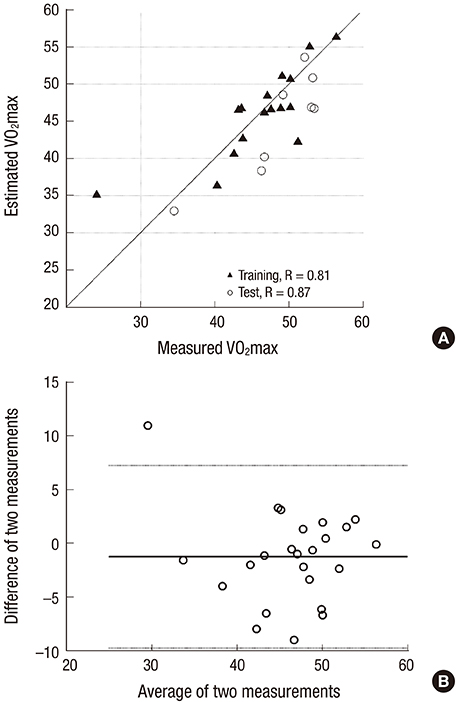J Korean Med Sci.
2017 Dec;32(12):1947-1952. 10.3346/jkms.2017.32.12.1947.
Unobtrusive Estimation of Cardiorespiratory Fitness with Daily Activity in Healthy Young Men
- Affiliations
-
- 1Interdisciplinary Program in Bioengineering, Seoul National University, Seoul, Korea.
- 2Research Institute, National Medical Center, Seoul, Korea.
- 3Department of Biomedical Engineering, Medical Research Center, Seoul National University College of Medicine, Seoul, Korea. hjyoon@snu.ac.kr
- KMID: 2396370
- DOI: http://doi.org/10.3346/jkms.2017.32.12.1947
Abstract
- Despite the importance of cardiorespiratory fitness, no practical method exists to estimate maximal oxygen consumption (VOâ‚‚max) without a specific exercise protocol. We developed an estimation model of VOâ‚‚max, using maximal activity energy expenditure (aEEmax) as a new feature to represent the level of physical activity. Electrocardiogram (ECG) and acceleration data were recorded for 4 days in 24 healthy young men, and reference VOâ‚‚max levels were measured using the maximal exercise test. aEE was calculated using the measured acceleration data and body weight, while heart rate (HR) was extracted from the ECG signal. aEEmax was obtained using linear regression, with aEE and HR as input parameters. The VOâ‚‚max was estimated from the aEEmax using multiple linear regression modeling in the training group (n = 16) and was verified in the test group (n = 8). High correlations between the estimated VOâ‚‚max and the measured VOâ‚‚max were identified in both groups, with a 15-hour recording being sufficient to produce a highly accurate VOâ‚‚max estimate. Additional recording time did not significantly improve the accuracy of the estimation. Our VOâ‚‚max estimation method provides a robust alternative to traditional approaches while only requiring minimal data acquisition time in daily life.
Keyword
MeSH Terms
Figure
Reference
-
1. Chen KY, Bassett DR Jr. The technology of accelerometry-based activity monitors: current and future. Med Sci Sports Exerc. 2005; 37:S490–S500.2. Chen KY, Sun M. Improving energy expenditure estimation by using a triaxial accelerometer. J Appl Physiol. 1985; 1997:2112–2122.3. Plasqui G, Bonomi AG, Westerterp KR. Daily physical activity assessment with accelerometers: new insights and validation studies. Obes Rev. 2013; 14:451–462.4. Caspersen CJ, Powell KE, Christenson GM. Physical activity, exercise, and physical fitness: definitions and distinctions for health-related research. Public Health Rep. 1985; 100:126–131.5. Blair SN, Kampert JB, Kohl HW 3rd, Barlow CE, Macera CA, Paffenbarger RS Jr, Gibbons LW. Influences of cardiorespiratory fitness and other precursors on cardiovascular disease and all-cause mortality in men and women. JAMA. 1996; 276:205–210.6. Lee DC, Artero EG, Sui X, Blair SN. Mortality trends in the general population: the importance of cardiorespiratory fitness. J Psychopharmacol. 2010; 24:27–35.7. Park M, Ko Y, Song SH, Kim S, Yoon HJ. Association of low aerobic fitness with hyperfiltration and albuminuria in men. Med Sci Sports Exerc. 2013; 45:217–223.8. Garber CE, Blissmer B, Deschenes MR, Franklin BA, Lamonte MJ, Lee IM, Nieman DC, Swain DP. American College of Sports Medicine. American College of Sports Medicine position stand. Quantity and quality of exercise for developing and maintaining cardiorespiratory, musculoskeletal, and neuromotor fitness in apparently healthy adults: guidance for prescribing exercise. Med Sci Sports Exerc. 2011; 43:1334–1359.9. Helgerud J, Høydal K, Wang E, Karlsen T, Berg P, Bjerkaas M, Simonsen T, Helgesen C, Hjorth N, Bach R, et al. Aerobic high-intensity intervals improve VO2max more than moderate training. Med Sci Sports Exerc. 2007; 39:665–671.10. Bruce RA, Kusumi F, Hosmer D. Maximal oxygen intake and nomographic assessment of functional aerobic impairment in cardiovascular disease. Am Heart J. 1973; 85:546–562.11. Noonan V, Dean E. Submaximal exercise testing: clinical application and interpretation. Phys Ther. 2000; 80:782–807.12. Kline GM, Porcari JP, Hintermeister R, Freedson PS, Ward A, McCarron RF, Ross J, Rippe JM. Estimation of VO2max from a one-mile track walk, gender, age, and body weight. Med Sci Sports Exerc. 1987; 19:253–259.13. Plasqui G, Westerterp KR. Accelerometry and heart rate as a measure of physical fitness: proof of concept. Med Sci Sports Exerc. 2005; 37:872–876.14. Plasqui G, Westerterp KR. Accelerometry and heart rate as a measure of physical fitness: cross-validation. Med Sci Sports Exerc. 2006; 38:1510–1514.15. Cao ZB, Miyatake N, Higuchi M, Ishikawa-Takata K, Miyachi M, Tabata I. Prediction of VO2max with daily step counts for Japanese adult women. Eur J Appl Physiol. 2009; 105:289–296.16. Cao ZB, Miyatake N, Higuchi M, Miyachi M, Ishikawa-Takata K, Tabata I. Predicting VO2max with an objectively measured physical activity in Japanese women. Med Sci Sports Exerc. 2010; 42:179–186.17. Kaminsky LA. American College of Sports Medicine. ACSM's Health-Related Physical Fitness Assessment Manual. 3rd ed. Philadelphia, PA: Wolters Kluwer/Lippincott Williams & Wilkins Health;2010.18. Burns A, Greene BR, McGrath MJ, O'Shea TJ, Kuris B, Ayer SM, Stroiescu F, Cionca V. SHIMMER™ - a wireless sensor platform for noninvasive biomedical research. IEEE Sens J. 2010; 10:1527–1534.19. Trost SG, McIver KL, Pate RR. Conducting accelerometer-based activity assessments in field-based research. Med Sci Sports Exerc. 2005; 37:S531–S543.20. Kligfield P, Gettes LS, Bailey JJ, Childers R, Deal BJ, Hancock EW, van Herpen G, Kors JA, Macfarlane P, Mirvis DM, et al. Recommendations for the standardization and interpretation of the electrocardiogram: part I: the electrocardiogram and its technology: a scientific statement from the American Heart Association Electrocardiography and Arrhythmias Committee, Council on Clinical Cardiology; the American College of Cardiology Foundation; and the Heart Rhythm Society: endorsed by the International Society for Computerized Electrocardiology. Circulation. 2007; 115:1306–1324.21. Pan J, Tompkins WJ. A real-time QRS detection algorithm. IEEE Trans Biomed Eng. 1985; 32:230–236.22. Bosquet L, Gamelin FX, Berthoin S. Reliability of postexercise heart rate recovery. Int J Sports Med. 2008; 29:238–243.23. Campos EZ, Bastos FN, Papoti M, Freitas IF Junior, Gobatto CA, Balikian P Junior. The effects of physical fitness and body composition on oxygen consumption and heart rate recovery after high-intensity exercise. Int J Sports Med. 2012; 33:621–626.24. Sartor F, Vernillo G, de Morree HM, Bonomi AG, La Torre A, Kubis HP, Veicsteinas A. Estimation of maximal oxygen uptake via submaximal exercise testing in sports, clinical, and home settings. Sports Med. 2013; 43:865–873.25. Weyand PG, Kelly M, Blackadar T, Darley JC, Oliver SR, Ohlenbusch NE, Joffe SW, Hoyt RW. Ambulatory estimates of maximal aerobic power from foot -ground contact times and heart rates in running humans. J Appl Physiol. 1985; 2001:451–458.26. Tönis TM, Gorter K, Vollenbroek-Hutten MM, Hermens H. Comparing VO2max determined by using the relation between heart rate and accelerometry with submaximal estimated VO2max. J Sports Med Phys Fitness. 2012; 52:337–343.
- Full Text Links
- Actions
-
Cited
- CITED
-
- Close
- Share
- Similar articles
-
- Association of Cardiorespiratory Fitness with Insulin Resistance, Blood Lipids and Bone Mineral Density in Young Female Adults
- Association between Estimated Cardiorespiratory Fitness and Insulin Resistance in Korean Adults: Results from the Korea National Health and Nutrition Survey 2019–2021
- Development and Cross-Validation of Non-exercise–based Prediction Equations for Estimating Cardiorespiratory Fitness in Korean College Students
- Heart Rate Responses at Rest, during Exercise and after Exercise Periods in Relation to Adiposity Levels among Young Nigerian Adults
- Effects of Taebo Exercise on Cardiorespiratory Fitness and Metabolic Risk Factors in Elementary School Children




